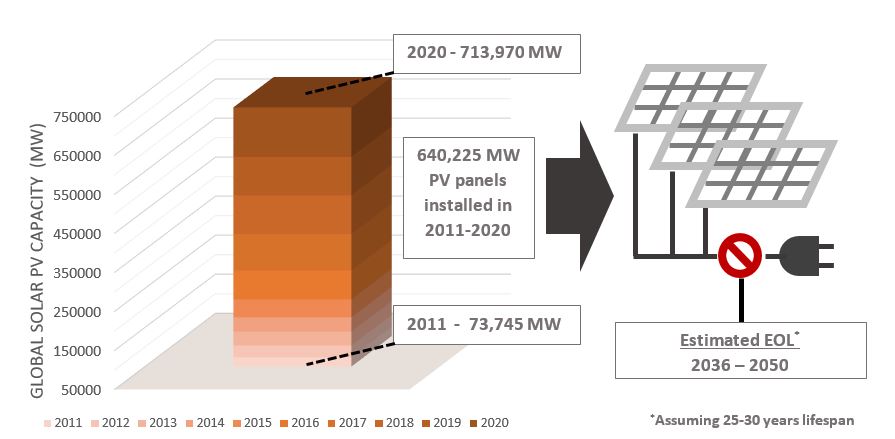11/11/2021
Despite the scepticism they faced over the past few decades, renewables continues to become increasingly competitive in the energy landscape. In particular, the solar energy industry has seen an extremely rapid development in the past decade. In 2020 alone, we saw over 127 GW of new photovoltaic (PV) power generation capacity installed, leading to the total global PV power generation capacity of 707.5 GW (702.9 GW on-grid and 4.584 MW of off-grid [1]) at the end of 2020. This means more than one fifth of renewable energy in the world today is generated by PV technology.
Solar boom
This recent “solar boom” has been driven by technical advances in PV technology which have allowed for not only the optimisation in gathering and producing energy, but also a reduction of its associated costs. According to IRENA’s recent report [2], the global weighted-average total installed cost of utility scale solar PV fell from 4 731 USD/kW to 883 USD/kW between 2010 and 2020. Over the same period, the levelised cost of electricity (LCOE) from utility-scale solar PV also fell by 85% between 2010 and 2020, recording 0.057 USD/kWh. This figure is comparable to that of coal-fired power generation (which is the cheapest fossil-fuel competitor) option available in 2020 (0.05 USD/kWh). Given the cost savings over fossil fuels projected in the years to come alongside international efforts to respond to climate change, the rapid growth of global solar PV capacity is expected to continue for the foreseeable future.
“Dying” solar panels
However, whilst this should be welcome news in view of energy transition, the already large and increasing number of solar panel installations inevitably leads to a problem: What happens to solar panels when they reach the end-of-life (EOL)? So far, EOL disposal of solar panels has not caused too much concerns as solar panels only started being widely deployed in the early 2000s and the industry standard lifespan of solar panels is about 25 to 30 years (although many believe that the actual lifespan may be as long as 35 to 40 years). However, given that most of the solar panels in the world were installed in the past decade (2011-2020) we are likely to see a sudden increase in the number of dead solar panels starting from mid-2030s. To give you a rough idea, PV panels installed in the past decade provide 640,225 MW total capacity which is equitant to over 2 billion 300W solar panels.

Figure 1 Global solar PV panel installations in 2011-2020 (data from [1]) and estimated EOL for panels installed in 2011-2020
EOL management of solar panels
The abovementioned mid-2030s timeline may make you think that it’s too early to worry about EOL management of solar panels. However, there are many good reasons why we should start taking this issue more seriously now. The good news is that many governments have already started introducing frameworks for recycling, reusing and, if neither is possible, disposing of dead solar panels. For example, in the UK and many European countries, collection, recycling and recovery targets for all types of electrical goods, such as solar panels, are set according to the Waste Electrical and Electronic Equipment Directive (WEEE Directive). It is questionable, however, whether the capacity of the existing recycling facilities dedicated to electrical and electronic waste would be able to cope with the ever-increasing volume of solar panel waste. Moreover, conventional recycling processes for general electrical and electronic waste may not be able to deliver the best material recovery rate for solar panel waste.
Material recovery
But why do we need to worry about how to reuse and recycle EOL solar panels and their parts? Although the most obvious answer to this question would be to minimise the environmental impact that such large volumes of solar panel waste can have on the planet, this isn’t just an environmental issue. Solar panels are made of many components, including PV cells (electricity-producing devices), electrical connections and support frame, all of which contain materials that can be reused or extracted for further use.
Currently, materials from EOL solar panels are typically recovered at general recycling plants (e.g. MRFs) alongside other types of electrical and electronic equipment. These material recovery processes typically involve shredding EOL solar panels into small pieces and mechanically separating major components and materials of the panels. Such processes can already achieve high overall material recovery rates that are in line with the existing regulations, such as EU WEEE Directive. However, processes involving shredding typically accompany loss of high-value materials, such as silver, which are dispersed in form of dusts during shredding. So far, due to the relatively low volume of solar panel waste, such losses have been considered to be negligible. However, without significant improvements of recycling process, the volume of unrecovered high-value materials would only increase along with the growing volume of solar panel waste.
Environmental impact
In view of the environmental impact, finding better ways to reuse and recycle EOL solar panels is an essential step of completing the sustainability cycle of solar PV power generation. Unlike the environmental impacts of manufacturing, installing, and maintaining solar panels and plants, the environmental impacts of dead solar panels have largely been neglected to date. However, according to a study [3], recycling 1,000 kg of silicon PV waste produces greenhouse gas emissions of 4.46×102 kg CO2eq, most of which comes from transporting solar panels waste to recycling facilities and incinerating plastic materials from the panels, and further treatment for metal recovery from the bottom ash. Given that burning 1 litre of petrol produces ~2.3 kg of CO2, this is equivalent to burning ~193 litres of petrol. Such EOL phase emission is not often taken into account when assessing the environmental impact of solar power generation. However, as the volume of solar panel waste grows, the impact of such emission would reach a significant level in coming years.
Future technologies
Thanks to the advances made in solar energy sector in the past two decades, the cost per kilowatt-hour of solar power generation is now comparable to the cheapest available fossil fuel-based power generation. The increased profitability of solar power means that government subsidy is no longer a requirement for large-scale solar projects and will also open up more opportunities for subsidy-free solar projects. This, in turn, will lead to further cost reductions through economies of scale.
However, although solar energy has come a long way, more work is still needed to make solar power generation more sustainable both socio-economically and environmentally. In particular, as discussed above, much work is need in relation to the EOL phase of solar panels to complete the sustainability cycle of PV power generation.
The problems relating to the EOL phase of solar panels, like other challenges the solar energy industry faced in the past, could be overcome by innovations. For example, developing recycling processes dedicated to PV panels could increase treatment capacities, improve the quality of extracted materials, and increase material recovery rate. More work can also be done to design solar panels to enable easy separation of panels parts or materials without having to use a shredder or thermal treatment. PV cell material research, which currently mainly focuses on improving cell efficiency, may also need to focus on making cell materials more easily reusable or recyclable. Moreover, improved monitoring methods for analysing “gate-to-gate” impact of EOL solar panels, considering all impacts from transporting solar panel waste to recycling plants up to sorting of the different recyclable materials and disposal of residues, may help us identify which aspects of the EOL phase needs more urgent improvement.
The increasing needs for innovations in the non-cell parts of PV systems will be good news for new businesses that wish to step into solar power industry. Perhaps the rapid increase in the number PV-related patent filings in recent years is not only a reflection of technological advances of PV cells, but also a sign of a wider range of innovations to come.
At Reddie & Grose we have extensive experience drafting and prosecuting patent applications covering cutting edge technological developments, ensuring that our clients are provided with high quality patents, which adequately protect their inventions. If you have a solar power-based invention, or would like more information, please contact one of our team.
This article is for general information only. Its content is not a statement of the law on any subject and does not constitute advice. Please contact Reddie & Grose LLP for advice before taking any action in reliance on it.
References
| [1] | IRENA, “Renewable capacity statistics 2021,” 2021. |
| [2] | IRENA, “Renewable Power Generation Costs in 2020,” 2021. |
| [3] | C. E. L. Latunussa, F. Ardente, G. A. Blengini and L. Mancini, “Life Cycle Assessment of an innovative re-cycling process for crystalline silicon photovoltaic panels,” Sol. Energy Mater. Sol. Cells, vol. 156, pp. 101-111, 2016. |


